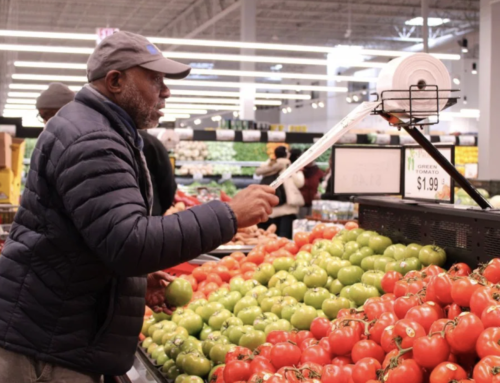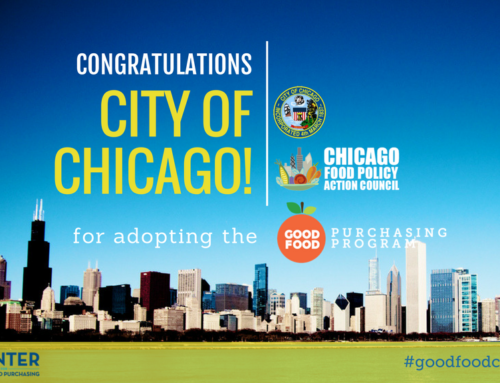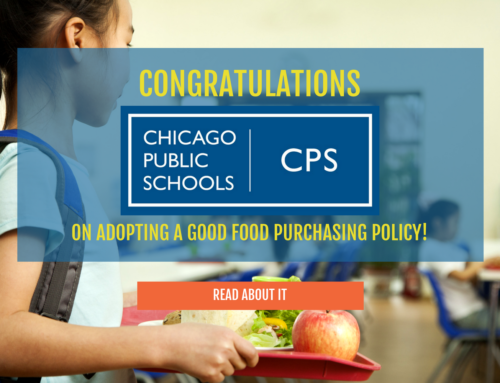When Leslie Fowler asked America’s largest chicken producers to increase their supply of antibiotic-free poultry, they gave her “the Heisman hand” and turned down the chief nutrition and facilities officer for Chicago Public Schools (CPS). But Fowler was on a mission to ensure that the nation’s third largest school system served better chicken, so she stopped placing orders with them. It took six months, but the chicken producers eventually responded to her call.
That was the fall of 2016. By the start of the 2017 school year, all chicken served in each of Chicago’s 646 public schools was antibiotic-free. “If you don’t speak up and tell people what you want, you’ll never get it,” Fowler recently told the audience at the Good Food Expo in Chicago. This victory convinced CPS that signing on to the Good Food Purchasing Program (GFPP) was not only a tenable option, but was also a vital pathway to better food.
In June 2017, CPS became the fourth school district and the first outside of California to adopt the GFPP, which will slowly but steadily shift the district to buy more nutritious food, sourced as locally as possible from environmentally and socially responsible companies. GFPP does not offer a “one-size fits all strategy or expectation,” said Colleen McKinney, the associate director of the Center for Good Food Purchasing, which administers the GFPP. Instead, each jurisdiction following the program’s guidelines agrees to improve its food supply in line with the GFPP’s five core values.
A few months after CPS adopted the program, the Chicago Park District, which manages parks, recreation, and event facilities, beaches, museums, and gardens throughout Chicago, and serves more than 2 million meals in its summer programs and another 30,000 throughout the year, also signed on to the program.
The Windy City took its commitment one step further: At the behest of Mayor Rahm Emanuel, and backed by research and training support from a dedicated task force, the city council last October approved GFPP across city operations. In doing so, Chicago became the latest major municipality to embrace the comprehensive Good Food Purchasing Program, following the city of Los Angeles, which adopted it in 2012. While CPS and the Park District are well on their way to meeting the program’s goals, other city agencies—notably family services and both airports—have until October to deliver a viable plan to do the same.
Putting the Program into Effect
In Chicago, young eaters citywide will begin seeing small changes in their food as soon as this summer while administrators will see “minimal price differences” in their budgets, said Rodger Cooley, executive director of Chicago Food Policy Action Council, which played a significant role in attracting interest at the city level. The biggest shifts in terms of changes to menus, ingredients, and sourcing are still 10 to 15 years down the road. He hopes that people will “start looking at food very differently, rather than just at price and availability,” he said. “The process is [about] demystifying it. It’s not as complex as people think.”
Cooley began exploring the program in January 2015 with Jose Oliva of the Food Chain Workers Alliance, a national coalition of food worker groups based in Chicago, and Mayor Emanuel quickly latched onto the program’s ideology. Over the next two years, the duo met with various city agencies, “deliberately talking through what will this mean,” said Cooley. “It’s not a mandate,” he added, but “more of a carrot program, an incentive program.”
In October, each city agency will present a baseline status report of their current suppliers and costs, as well as a plan to move forward. The goal, as Cooley explained, is to enact gradual changes that promote transparency and satisfy GFPP. He added that agencies should feel confident saying to their vendors, “there’s nothing to be afraid of.” Food companies vying for CPS or Park District business, for instance, “can out-compete each other within the value category,” explained Cooley. This quality competition, in theory, will compel food companies to increase their nutrition and sourcing standards.
Chicago Public Health Commissioner Dr. Julie Morita also underscored the direct correlation between food and health and its ramifications for the local community physically and commercially. “What we love about GFPP is it’s not just about nutritional value of food, but stressing local economies,” she said. “If we establish these standards, then they become the norm.”
The Park District and CPS already had plans to improve food quality and nutrition standards, but the city-wide adoption of the Good Food program strengthens the movement. “We’re all doing it now, and we might as well go it together,” said Colleen Lammel, the Park District’s wellness manager. Existing initiatives, such as meatless meals, have served as a foundation for discussion.
The Park District’s “yes” vote was one of the movement’s greatest victories, said Cooley. School districts were the obvious first choice because their buying power is so robust, he explained. “It’s a mix of political strategy plus the fact that they are the primary purchaser of food. The real goal is to influence food system providers.”
CPS, which budgeted $230 million in 2016 for breakfast, lunch, after-school and summer meals, works exclusively with Aramark and represents a huge contract for the concessions giant. In a statement provided to Civil Eats, Aramark’s Vice President of Communications Karen Cutler said the company would “work collaboratively with CPS” to meet Good Food guidelines but stressed adherence to nutrition standards “required under the federally funded USDA National School Lunch Program.”
Though Cutler declined to explain how Aramark might address new standards under GFPP, she pointed to the company’s partnership with FarmLogix, an Evanston-based tech company that connects smaller producers with large buyers like CPS through a “hub of hubs” model. Buyers can place orders with several farms, but FarmLogix takes care of pick-up, delivery, and payment. Cutler said this relationship has provided “fresher, healthier foods for children, as well as increased economic potential for Midwest farmers.”
To her point, the Park District’s Lammel recognized that despite the short growing season, plenty of wheat, corn, dairy and meat originates in the Midwest. “A lot of farmers are nearby,” she said, “but the farmers don’t know the vendors.” Currently, the Park District sources 7 percent of its food locally. Instead of bread, meals might include tortillas from Little Village, Chicago’s mecca of Latin manufacturing.
Persuading Every Step of Supply, from Farm to Table
On top of looking at worker standards “up and down the food chain,” Cooley agreed that shifts in procurement mean opportunities for small and medium-sized producers. “Who needs extra resources and investments?” he asked, and how can the city’s buying power help them?
Morita said that this “big idea” was pushed by Mayor Emanuel, and found a receptive audience, since the city spends more than $200 million dollars every year on food and nutrition programs. “If policy influences how these dollars are spent, this policy has incredible potential to impact wellness,” she said. Commitment to community matters, as does the city’s willingness to “invest in them in systemic ways.” But not everyone agrees the quest for quality is worth the cost.
Jeffrey Dorfman, professor of agricultural and applied economics at the University of Georgia and director of its Land Use Studies Initiative, penned an op-ed in Fortune the day after Chicago voted to approve the GFPP measure last October. He sees corruption as a potential pitfall, creating an uneven bidding process where certain companies are favored while others are ignored.
“Getting these contracts is good for the local producer, but it doesn’t bring more money into the local community—or not much,” Dorfman told Civil Eats. “The local purchases replace a purchase from a large supplier who employed local salespeople, warehouse workers, and delivery personnel.”
For Dorfman, local food remains a more expensive luxury. When asked about buying fresh, local produce grown year-round from a nearby greenhouse operation like Mighty Vine—as opposed to sourcing tomatoes from Mexico—Dorfman remained skeptical. “Georgia cannot compete with Illinois on price at growing corn and Illinois cannot compete with places like Arizona and Florida at growing produce,” he said, Buying tomatoes from MightyVine would still be more expensive, he added. “That’s fine for people with enough money who wish to make that choice,” said Dorfman, who added that he sometimes does. “It’s not okay when it’s taxpayer money and the people making purchasing decisions are using other people’s money,” he said.
Cooley counters that a narrow viewpoint like Dorfman’s ignores the systematic nature of the program. Each agency will find its own starting point and “avoid a shock to the system,” he said.
Similar to the popular LEED green building certification, the Good Food program offers tiered engagement without rigid rules. “Builders choose how they get to certain goals” in LEED, explained GFPP’s McKinney. Likewise, she added, the Good Food program provides a “flexible framework, somewhat standardized, with different pathways based on priorities” for each project. “It may not be exciting and sexy,” admitted Chicago public health commissioner Morita. “This is the kind of systemic change that makes a long-term difference.”
Lessons from Oakland
The Oakland Unified School District adopted the Good Food framework in 2014, but not before two full years of analyzing what the district was already doing well and what it wasn’t. “The downside is it’s so complex really looking at so many different pieces,” said Alex Emmott, who served as the district’s Farm to School Supervisor until January 2018. “You can’t react very quickly to buying $9 million worth of food.” Before officially taking on the Good Food Purchasing Program, she said, “we made sure it had some real meat to it.”
There are “creative ways to serve high-quality food and still stay on budget,” she noted. Her district has spent a smaller percentage of its budget on food in the last five years. She credits an increase in cooking from scratch, which offers better nutritional value at lower costs than processed foods. “You can’t make these changes on a school district budget and serve [only] processed foods. Higher nutrition for processed cooking is expensive. It’s all about creativity.”
Emmott admitted her job is not yet common, but she said school districts nationwide are hiring like-minded good food professionals to improve health and nutrition standards. As other districts follow suit, she cautioned that policies don’t have all the answers. “You can write whatever you want in a school board policy. Policy isn’t going to change anything,” she said. Oakland Unified focused instead on “hard data to back up claims,” which helped convince the school board that there was a better way to buy and make food for thousands of kids.
Changes and Limitations in Chicago
Lammel implements a similar credo at the Park District. Ideally, she would prefer to serve more fruit and vegetables with less pesticides, but realizes there are limitations. “Honestly, food quality and food safety is number one. Number two is having food that is grown fresher and transported fresher, which means more local,” she said, adding that these choices must also be cost-effective.
Among the changes that are coming—slowly—to CPS are more local chicken products. Miller Poultry, an Amish processor in northern Indiana, provides $2 million worth of drumsticks to CPS every year, and serves as an example of what happened when Leslie Fowler pushed chicken producers to increase their supply of antibiotic-free chicken for CPS and other school districts across the country.
Now, Fowler said they’re waiting for the supply to meet demand. Students see Miller’s drumsticks, which cost CPS about 75 cents per leg, only twice per month. Tyson, she said, charges about 42 to 47 cents for a commodity drumstick. Those hard choices are par for the course when it comes to providing higher-quality food for 70 million meals that feed 370,000 students. Today, CPS allots $1.40 of its own budget per plate, up from $1 five years ago; federal grants for before and after-school meal programs supplement that amount.
Up next are O’Hare International and Midway Airports, through which a combined 100.6 million passengers traveled in 2016, and Cook County as a whole. Despite whispers of preemptive state legislation that could hinder food policy making at the local level, Cooley foresees a bright future—the Cook County Board of Commissioners is set to vote on adopting the GFPP later this week.
Citywide, plenty of departments have been pursuing food initiatives that just don’t get attention, he said. For the public to embrace something like GFPP, people must recognize that “it’s not a new fact,” he contended. “It’s being smarter about using city resources, and leveraging it for benefits that people would like to see.”
Update: On May 16, 2018, the Cook County Board of Commissioners voted to adopt the GFPP.
Corrections: This article has been corrected to reflect the fact that Los Angeles was the first city to comprehensively commit to the GFPP, not Chicago, and to correct the school district that Alex Emmott worked at to the Oakland Unified School District, not the Los Angeles Unified School District. We regret the errors.
Top photo CC-licensed by the U.S. Department of Agriculture.





